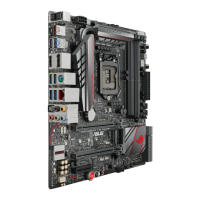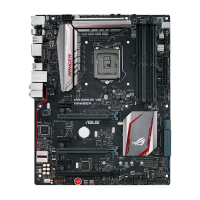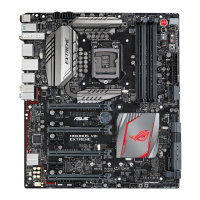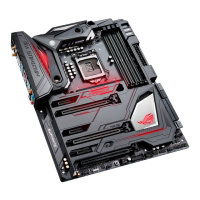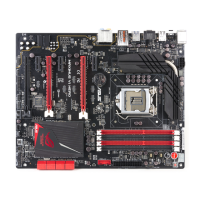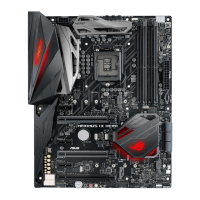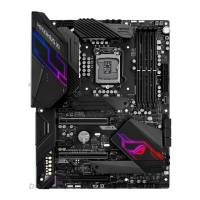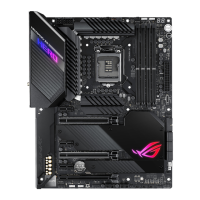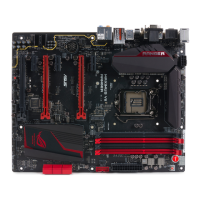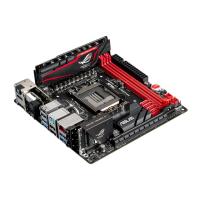Do you have a question about the Asus Maximus VIII Hero and is the answer not in the manual?
Information on preventing electrical hazards and safe practices.
Precautions for handling and operating the motherboard safely.
Explains the structure and content of the user guide.
Lists resources for additional product and software updates.
Explains symbols used to convey warnings, cautions, and important notes.
Explains text formatting conventions used in the manual.
Highlights key features of the motherboard and new technology.
Details the main selling points and features of the product.
Explains the M.2 slot capabilities and compatible SSD sizes.
Details the strategic USB 3.0 accessibility for front and rear panels.
Covers audio technologies and network features for gaming.
Details exclusive features for ROG enthusiasts and overclocking.
Describes ASUS-specific software utilities and features.
Lists bundled software like antivirus, utilities, and tools.
Provides essential precautions before installing motherboard components.
Illustrates the physical layout of motherboard components and connectors.
Lists motherboard connectors, jumpers, buttons, switches, and slots with page references.
Details CPU socket compatibility and installation guidelines.
Explains DDR4 DIMM slots and memory module installation.
Lists qualified vendors and part numbers for DDR4 3466MHz memory.
Lists qualified vendors and part numbers for DDR4 3400MHz memory.
Lists qualified vendors and part numbers for DDR4 3333MHz memory.
Lists qualified vendors and part numbers for DDR4 3200MHz memory.
Lists qualified vendors and part numbers for DDR4 3000MHz memory.
Lists qualified vendors and part numbers for DDR4 2800MHz memory.
Lists qualified vendors and part numbers for DDR4 2666MHz memory.
Lists qualified vendors and part numbers for DDR4 2400MHz memory.
Lists qualified vendors and part numbers for DDR4 2133MHz memory.
Details the PCIe slots, their numbering, and specifications.
Describes the function of onboard power and reset buttons.
Details the power-on (START) and reset (RESET) buttons functionality.
Explains the MemOK! button for memory compatibility tuning.
Describes the Clear CMOS button for resetting BIOS settings.
Explains the purpose and function of onboard LEDs for system status.
Details the Hard Disk LED and Q LEDs for system diagnostics.
Describes the Q-Code LED for displaying system status and error codes.
Details jumper settings, including the LN2 mode jumper.
Explains the LN2 Mode jumper for cold-boot bug remedy.
Provides a guide to the motherboard's internal connectors.
Details the SATA 6 Gb/s connectors and RAID configuration.
Describes the ASMedia SATA 6 Gb/s connectors for hard drives.
Explains the USB 3.0 connector for additional ports and faster transfer.
Details the USB 2.0 connectors for connecting USB modules.
Describes the AAFP connector for chassis-mounted front panel audio.
Details connectors for CPU, pump, and chassis fans, with connection guidance.
Explains the ATX power connectors and PSU requirements.
Describes connectors for system LEDs, power/reset buttons, and speaker.
Details the ROG_EXT connector for OC Panel and other ROG devices.
Explains the TPM connector for enhanced security and platform integrity.
Describes the T_SENSOR connector for monitoring component temperatures.
Details the M.2 slot supporting PCIe/SATA SSDs and its bandwidth sharing.
Explains the TB_HEADER for add-on Thunderbolt I/O cards and daisy-chaining.
Guides through the steps of assembling a PC system.
Details the process of installing the motherboard into the PC chassis.
Provides step-by-step instructions for installing the CPU into the socket.
Guides on applying thermal material and installing the CPU heatsink/fan.
Explains how to install and remove RAM modules (DIMMs).
Details how to connect the ATX power supply cables to the motherboard.
Guides on connecting SATA hard drives and optical drives.
Explains connections for Q-Connectors, USB, and front panel audio.
Details the procedure for installing PCIe x16 expansion cards.
Lists utilities for updating BIOS: EZ Update, EZ Flash 3, CrashFree BIOS, Updater.
Describes the USB BIOS Flashback feature for updating BIOS via USB.
Identifies and explains the rear panel connectors for I/O devices and audio.
Identifies and explains the rear panel connectors for I/O devices.
Guides on initial system power-up, POST, and BIOS beep codes.
Lists beep codes and their corresponding error descriptions for diagnostics.
Introduces the ASUS UEFI BIOS and its importance for system settings.
Explains how to enter and navigate the BIOS setup program.
Details methods to access the BIOS setup at startup or after POST.
Provides an overview of the BIOS EZ Mode interface and basic settings.
Introduces the BIOS Advanced Mode for detailed configuration options.
Explains the BIOS menu bar, menu items, and submenu navigation.
Allows saving and accessing frequently used BIOS items for easy configuration.
Displays system information and allows setting date, time, language, and security.
Covers system security settings, including password management.
Details setting, changing, and clearing Administrator and User BIOS passwords.
Configures overclocking-related items like CPU frequency and memory.
Selects CPU overclocking options: Auto, Manual, or X.M.P.
Adjusts Base Clock frequency, amplitude, slew rate, and CPU core ratio.
Configures DRAM odd ratio mode and frequency ratios.
Covers DRAM frequency, Xtreme Tweaking, TPU, EPU, and SVID support.
Adjusts memory timings, DIMM control, VRM settings, and CPU load-line.
Configures CPU current capability, VRM switching frequency, and spread spectrum.
Manages CPU power duty, phase control, thermal control, and graphics voltage.
Configures CPU graphics frequency, GT power phase, and DRAM power settings.
Adjusts CPU Core/Cache, DRAM, DMI, and other critical voltages.
Configures CPU ratios, current limits, and power limits.
Fine-tunes CPU and graphics voltages using override and offset modes.
Details various system voltages like DRAM, DMI, VCCIO, and System Agent.
Allows changing settings for CPU and other system devices.
Shows CPU information and allows configuration of cores, virtualization, and prefetchers.
Configures active CPU cores, virtualization, and cache line prefetchers.
Manages CPU power states, Turbo Mode, C-States, and CFG Lock.
Configures platform-related features like PCI-E power management.
Enables PCI-E power saving and controls ASPM for devices.
Manages ASPM support levels and PEG 0 power management.
Configures VT-d, graphics output, and DMI/OPI settings.
Sets primary display, multi-monitor output, and DMI link speed.
Configures PEG port settings, including link speed for PCIEX16/X8_1 and PCIEX8_2.
Controls onboard LEDs for system status and audio features.
Configures PCI Express slots speed and PCH settings.
Manages SATA port configurations, RAID support, and hot plug.
Configures SATA controllers, modes (AHCI/RAID), M.2 RAID, and storage hot plug.
Manages USB features like legacy support, XHCI hand-off, and port control.
Configures legacy USB support, XHCI hand-off, and individual USB port control.
Configures network stack and PXE boot options.
Enables/disables onboard devices like audio, PCIe bandwidth, and USB controllers.
Controls HD Audio, PCIe bandwidth, USB 3.1, and USB Type-C power.
Manages ASMedia storage, hot-plug notifications, ASPM, and Intel LAN PXE ROM.
Configures ACPI Power Management settings like ErP Ready and power-on behavior.
Manages ErP Ready, AC power loss restore, and wake-on-LAN/RTC features.
Displays SMART information for connected storage devices.
Configures Intel Thunderbolt technology and boot support.
Displays system temperature, power status, and allows fan control.
Allows automatic fan speed detection and manual fan control tuning.
Configures CPU fan behavior based on temperature and fan type (PWM/DC).
Sets CPU fan profiles (Standard, Silent, Turbo, Manual) and duty cycles.
Configures chassis fan speed and sources for temperature monitoring.
Adjusts chassis fan step up/down, low limits, profiles, and duty cycles.
Manages Extension Fan speed, Q-Fan source, and profiles.
Sets Extension fan duty cycles, water pump control, and anti-surge protection.
Allows changing system boot options.
Configures fast boot options and SATA device detection during POST.
Manages USB/PS2 support, network stack, boot logo, and NumLock state.
Configures 4G decoding, error reporting, setup mode, and CSM for compatibility.
Manages Secure Boot settings, OS types, and cryptographic keys.
Manages DB, DBX keys and sets boot device priority sequence.
Provides access to BIOS utilities like EZ Flash 3, Secure Erase, and Overclocking Profiles.
Lists and describes various BIOS utilities for system management.
Allows storing, loading, and managing multiple BIOS settings as profiles.
Configures CPU voltage, BCLK, and ratio for OC Panel synchronization.
Displays detailed DRAM SPD information based on DIMM slot.
Shows graphics card information and recommended PCIe slot configurations.
Provides options for exiting the BIOS setup.
Provides options to load defaults, save changes, discard changes, or launch EFI Shell.
Provides information and procedures for updating the system BIOS.
Lists utilities for updating BIOS: EZ Update, EZ Flash 3, CrashFree BIOS, Updater.
Guides on updating BIOS using the EZ Flash 3 utility via USB.
Explains BIOS recovery using support DVD or USB flash drive.
Details updating BIOS in DOS environment using USB flash drive.
Lists supported OS versions and general setup guidance.
Explains how to run the support DVD and access its contents.
Guides on how to launch the support DVD's AutoPlay.
Guides on accessing software manuals from the support DVD.
Overview of applications on the support DVD and their wizards.
Details the installation process for the AI Suite 3 utility.
Provides instructions to launch AI Suite 3 on different Windows versions.
Describes the AI Suite 3 main menu interface and its utilities.
Combines TPU, EPU, DIGI+ Power, Fan Xpert, Turbo App for system optimization.
Dynamically optimizes PC performance, energy, cooling, and fan control.
Allows manual adjustment of CPU frequency, cache, and voltages for performance.
Adjusts CPU frequency, ratio, cache ratio, and core tuning.
Manages CPU graphics voltage and settings for performance tuning.
Optimizes power usage, reduces fan noise, and extends hardware lifespan.
Features digital VRM and DRAM voltage controllers for precise tuning.
Provides customizable fan settings for CPU and chassis fans with auto-tuning.
Customizes system performance, network priority, and audio for applications.
Allows fast charging of portable devices via USB port.
Speeds up USB storage transfer rates using UASP protocol.
Utility for updating motherboard software, drivers, and BIOS.
Displays detailed motherboard, CPU, and memory information.
Shows detailed specifications for motherboard and CPU components.
Displays detailed memory SPD information.
Shares PC keyboard/mouse or streams audio to smart devices.
Monitors system status and sends alerts to smart devices.
Guides on pairing the computer with a smart device for Push Notice.
Configures PC mode alerts (restart, sleep) and status alerts (voltage, temp).
Allows sending messages and viewing computer status on smart devices.
Covers audio features including Sonic Studio II and DTS Connect.
Guides on installing and using Sonic Studio II audio suite.
Explains audio controls like Reverb, Bass Boost, Equalizer, Voice Clarity.
Details equalizer, bass boost, voice clarity, surround, reverb, and test tone functions.
Covers voice enhancement features: Volume Stabilizer, Noise Gate, Noise Reduction.
Enhances sound quality for streaming and recording sessions.
Features headphone AMP with automatic impedance detection and level adjustment.
Provides surround sound entertainment and PC connection to home theatre.
Enhances FPS game audio with precise direction and intensity indicators.
Explains Display and Control menus for game audio customization.
Allows configuration of sound enhancers and shortcut keys for game audio.
Network management software for packet prioritization and bandwidth allocation.
Details Optimization, Game, Media Streaming, and File Sharing modes.
Monitors top applications, individual usage, and total bandwidth.
Tests ISP speed and displays network card details.
Upgrades keyboard functionality with macros, smart input, and BIOS access.
Explains Macro Keys, Smart Input, Function Keys, and Shortcut settings.
Streams PC multimedia content to smart devices or TVs.
Guides on managing media files and folders for streaming.
Software to create high-speed virtual drives using system memory.
Guides on creating, deleting, formatting RAMDisk drives and setting size.
Explains creating and deleting junction points for RAMDisk access.
Manually synchronizes RAMDisk updates with backup files.
Software to view memory timings, validate settings, and generate efficiency scores.
Guides on validating and saving configuration online or manually.
Gathers system information (CPU, Mobo, Memory) in an ROG layout.
Displays system information and status of CPU, motherboard, memory, etc.
Utilizes system memory to cache application data for faster performance.
Guides on launching RAMCache and selecting disk/partition for caching.
Covers Intel Rapid Storage Technology for RAID 0, 1, 10, and 5.
Explains RAID 0 (striping), RAID 1 (mirroring), RAID 5, and RAID 10.
Guides on installing SATA HDDs for optimal performance in RAID.
Details enabling RAID function in BIOS Setup via SATA Configuration.
Explains how to enter and navigate the Intel RST Option ROM utility.
Guides on creating a RAID volume using the Intel RST utility.
Provides steps and warnings for deleting a RAID set and resetting disks.
Explains the need for a RAID driver disk and its creation process.
Details creating a RAID driver disk using the support DVD without entering the OS.
Guides on creating a RAID driver disk within Windows OS.
Explains loading the RAID driver during Windows OS installation.
Contains FCC statements regarding device compliance and interference.
Covers IC, NMB-003, and Canadian Dept. of Communications statements.
Details REACH compliance, product disposal, and recycling services.
Provides contact details for ASUS support in different regions.
| Form Factor | ATX |
|---|---|
| Chipset | Intel Z170 |
| Socket | LGA 1151 |
| Memory Slots | 4 |
| Maximum Memory | 64GB |
| Memory Type | DDR4 |
| PCIe x16 Slots | 3 |
| PCIe x4 Slots | 0 |
| PCIe x1 Slots | 3 |
| SATA 6Gb/s Ports | 6 |
| M.2 Slots | 1 |
| USB 3.0 Ports | 6 |
| USB 2.0 Ports | 6 |
| Memory Speed | DDR4 2133/2400/2666/2800/3000/3200/3333/3400/3466 MHz (OC) |
| USB 3.1 Ports | 1 x USB 3.1 Type-A, 1 x USB 3.1 Type-C |
| Audio | 8-Channel High Definition Audio CODEC |
| LAN | Intel I219-V Gigabit LAN |
| RAID Support | 0, 1, 5, 10 |
| Multi-GPU Support | AMD 3-Way CrossFireX |
